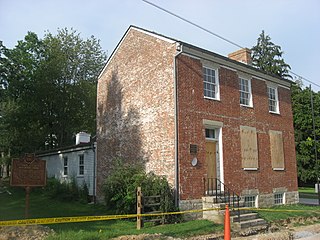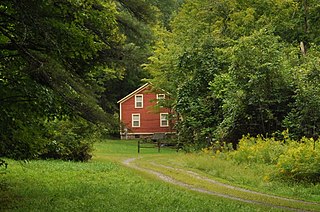
The Cole–Hasbrouck Farm Historic District is a historic home and farm and national historic district located along NY 32 north of the junction with US 44 and NY 55 at Modena, Ulster County, New York, USA. The district encompasses 21 contributing buildings, 4 contributing sites, and 5 contributing structures on a farm established in the 1820s. The main house was built about 1820, and is a two-story, five bay, brick and stone dwelling with a side gable roof. It has a two-story rear frame ell that subsumes and earlier 1 1/2-story kitchen ell. Other contributing resources are related to the house landscape and dependencies, the farm complex, and a hamlet that grew in the 1850s at the crossroads.

The Charles Payne House is an historic site at 25 Brown Street in Pawtucket, Rhode Island. The house was built in 1855–56 by Charles Payne and later expanded with the addition of two ells and a porch. The 1 1⁄2-story Gothic-Italianate vernacular cottage is architecturally significant as a 19th-century vernacular cottage in a picturesque setting. Though the round-head picket fence and entry gates were later removed, the property retains a large shaded garden on with ample street frontage. The Charles Payne House was added to the National Register of Historic Places in 1983.

Philetus Swift House is a historic home located at Phelps in Ontario County, New York. The limestone dwelling was built in two stages between 1792 and 1816. It is distinguished by a 2 1⁄2-story, three-bay side-hall Federal-style main block (1816) and 2-story side ell (1792). Also on the property are two contributing barns.

The Grant Boyhood Home is a historic house museum at 219 East Grant Avenue in Georgetown, Ohio. Built in 1823, it was where United States President and American Civil War General Ulysses S. Grant (1822-85) lived from 1823 until 1839, when he left for the United States Military Academy at West Point. In 1976, the house was listed on the National Register of Historic Places. Nine years later, it was designated a National Historic Landmark. It is now owned by a local nonprofit organization as part of a suite of Grant-related museum properties in Georgetown.

Job and Deborah Otis House, also known as East Otis Farm, is a historic home located at Sherwood in Cayuga County, New York. It is a Federal-style dwelling built in 1796. It consists of a 2-story, three-bay, side-hall main block with a 1 1⁄2-story side ell. Also on the property is a mid- to late-19th-century carriage house, now converted into a two car garage. During the 1840s the dwelling was home to Job and Deborah Otis, who were Orthodox Quakers and leaders of the Otisites. Their granddaughter was the painter Amy Otis.

Deodatus Royce House is a historic home located at Berkshire in Tioga County, New York. It is a two-story, five-bay, Federal style house built of brick about 1830. A single story ell extends from the rear.

Morris Clinton House is a historic home located at Newark Valley in Tioga County, New York. It was built in 1881 and is an L-shaped, 2 1⁄2-story, frame house, with a 2-story wood shed wing at the north end of the rear ell. In 1882, the house was featured in an agricultural journal as an example of progressive rural architecture. Also on the property are a milk house, two small livestock sheds, and a garage or small carriage house.

The Dan Bradley House is a historic house located at 59 South Street in Marcellus, Onondaga County, New York.

Reuter Dyer House is a historic home and farm complex located at Cape Vincent in Jefferson County, New York. The limestone farmhouse was built about 1839 and has three sections: a 1 1⁄2-story, three-bay main block; a 1-story side wing; and a 1-story wooden ell projecting from the wing. Also on the property are two 19th-century barns.

The Charles Ford House is a historic house located at Orleans in Jefferson County, New York.

Gardner Cox House is a historic home located at Hannawa Falls in St. Lawrence County, New York. It was built in 1838 and is a two-story, late Federal style stone structure, with a single story wood framed ell.

Nathaniel Parmeter House is a historic home located at Potsdam in St. Lawrence County, New York. It was built about 1830 and is a 1 1⁄2-story, three-by-two-bay, gable-roofed rural Federal-style residence constructed of red Potsdam Sandstone in the slab and binder style. A 1-story frame ell was removed in 1935.

Lucas Krom Stone House is a historic home located at Rochester in Ulster County, New York. The property includes the house, Dutch barn, and smokehouse. The house is a linear 1 1⁄2-story stone dwelling built in two sections. In the rear is a two-story frame ell.

Hiram Congdon House is a historic home located at Putnam in Washington County, New York. It was built about 1848 and is a 1 1⁄2-story, five-by-two-bay, side-gabled frame building with a 1-story ell. The main block is a 32-by-24-foot heavy timber-frame structure set on a rubble stone foundation.

Asa Stower House is a historic home located at Queensbury, Warren County, New York. It was a 2 1⁄2-story, five-by-two-bay, 2-story, side-gabled residence, with a rear ell wing and slate roof in a Federal style. It was built in four phases: a pre-1806 original frame residence incorporated into the rear ell; the c. 1806 main block; renovations dated to about 1850 that added Greek Revival elements; and the Italianate-style front porches added about 1870. It is located adjacent to the Sanford House.

Stephen Pangburn House is a historic home located at Guilderland in Albany County, New York. It was built in 1864 and is a two-story frame farmhouse with one story ell. It features attic story eyebrow windows on the ell and unusual pedimented lintels at the windows and doors.

Henry-Remsen House was a historic home located at Colonie in Albany County, New York. It was an example of a Greek Revival–style farmhouse. The earliest portion of the house, a 1 1⁄2-story ell, was built between about 1830 and 1850. The main structure was two stories with a pedimented gable roof. Other additions were completed between 1860 and the 1920s. Also on the property was a contributing barn. It is no longer extant; it has been dismantled.

Albert Slingerlands House is a historic home located at Slingerlands in Albany County, New York. It was built about 1840 and is a 2-story, frame Greek Revival–style dwelling. It consists of a 2-story, gable-front main block with a 1 1⁄2-story side ell with a projecting porch. Also on the property are two 2-story frame barns dated to about 1840 and a brick smoke house.

George W. Denton House is a historic home located at Flower Hill in Nassau County, New York. It was built in 1873 and is a rectangular, 2-story wood frame building with a two-stage rear service ell in a vernacular Italian Villa style. It features a 2 1⁄2-story engaged tower, semi-octagonal bay windows, and an "L" shaped wraparound verandah. Also on the property is a brick ice house built into the side of a hill.

Amos Wood House is a historic home located near North Landing, Ellisburg in Jefferson County, New York. The house was built in 1826, and consists of three sections: the main block, ell, and service addition. The limestone main block is a 1 1/2-story, five bay structure. The one-story limestone ell has a frame upper structure. The two-story frame service addition is attached to the ell. Also on the property is a contributing late-19th century sugar house and early-20th century chicken coop.















